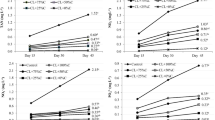Synopsis
The effect of two contrasting fertilization regimes on juvenile walleye growth, survival and harvest was tested in six identical rearing ponds treated with fermented soybean meal at either a constant (36 g m−3week−1) or a progressively reduced (32 to 0 g m−3week−1) rate. Walleye length, percent survival and biomass harvest in constant fertilization ponds were 32, 83 and 294% greater, respectively, than those of reduced fertilization ponds. Chironomid larvae and pupae were the dominant prey (in terms of biomass) in juvenile walleye larger than 22 mm TL. Mean chironomid biomass was significantly higher in the constant fertilization ponds (5.1 vs. 1.7 g dry wt m−2), particularly after peak emergence around week 4. Zooplankton were less important prey after week 2, and mean zooplankton density was not significantly different between treatments. From these data we conclude that better walleye performance in the constant fertilization ponds was due to higher chironomid density during the last half of the experiment. Our findings are reviewed in light of current knowledge of juvenile walleye feeding ecology and contemporary pond culture procedures.
Similar content being viewed by others
References cited
APHA (American Public Health Association), American Water Works Association & Water Pollution Control Federation. 1975. Standard methods for the examination of waters and wastewaters; 14th ed. American Public Health Association, Washington, D.C.
Bulkley, R.V., V.L. Spykermann & L.E. Inmon. 1976. Food of the pelagic young of walleyes and five cohabiting fish species in Clear Lake, Iowa. Trans. Amer. Fish. Soc. 105: 77–83.
Culver, D.A., M.M. Boucherle, D.J. Bean & J.W. Fletcher. 1985. Biomass of freshwater crustacean zooplankton from length-weight regressions. Can. J. Fish. Aquat. Sci 42: 1380–1390.
Dobie, J. 1956. Walleye pond management in Minnesota. Prog. Fish-Cult. 17: 51–57.
Dobie, J. 1969. Growth of walleye and sucker fingerlings in Minnesota rearing ponds. Verh. Int. Verein. Limnol. 17: 641–649.
Geiger, J.G. 1983. Zooplankton production and manipulation in striped bass rearing ponds. Aquaculture 35: 331–351.
Geiger, J.G., C.J. Turner, K. Fitzmayer & W.C. Nichols. 1985. Feeding habits of larval and fingerling striped bass and zooplankton dynamics in fertilized rearing ponds. Prog. Fish-Cult. 47: 213–223.
Hall, D.J., W.E. Cooper & E.E. Werner. 1970. An experimental approach to the production dynamics and structure of freshwater animal communities. Limnol. Oceanogr. 15: 839–928.
Johnson, F.H. 1969. Environmental and species associations of the walleye in Lake Winnibigoshish and connected waters, including observations on food habits and predator-prey relationships. Minnesota Fisheries Investigations 5: 5–36.
Mason, C.F. 1977. Populations and production of benthic animals in two contrasting shallow lakes in Norfolk. J. Anim. Ecol. 46: 147–172.
Mathias, J.A. & S. Li, 1982. Feeding habits of walleye larvae and juveniles: comparative laboratory and field studies. Trans. Amer. Fish. Soc. 111: 722–735.
Miller, F. 1952. Walleyed pike fingerling production in drainable constructed ponds in Minnesota. Prog. Fish-Cult. 14: 173–176.
Oliver, D.R. 1971. Life history of the Chironomidae. Ann. Rev. Entomol. 16: 211–230.
Paulus, R.D. 1969. Walleye fry food habits in Lake Erie. Ohio Fish Monograph No. 2, Ohio Department of Natural Resources. Columbus. 45 pp.
Priegel, G.R. 1969. Food and growth of young walleyes in Lake Winnebago, Wisconsin, Trans. Amer. Fish. Soc. 98: 121–124.
Smith, L.L. & J.B. Moyle. 1943. Factors influencing production of yellow pike-perch, Stizostedion vitreum vitreum, in Minnesota rearing ponds. Trans. Amer. Fish. Soc. 73: 243–261.
Smock, L.A. 1980. Relationships between body size and biomass of aquatic insects. Freshw. Biol. 10: 375–383.
Walker, R.E. & R.L. Applegate. 1976. Growth, food and possible ecological effects of young-of-the-year walleyes in a South Dakota prairie pothole. Prog. Fish-Cult. 38: 217–220.
Wasilewska, B.E. 1978. Bottom fauna in ponds with intense fish rearing. Ekologia Polska 26: 512–536.
Author information
Authors and Affiliations
Rights and permissions
About this article
Cite this article
Fox, M.G., Keast, J.A. & Swainson, R.J. The effect of fertilization regime on juvenile walleye growth and prey utilization in rearing ponds. Environ Biol Fish 26, 129–142 (1989). https://doi.org/10.1007/BF00001029
Received:
Accepted:
Issue Date:
DOI: https://doi.org/10.1007/BF00001029




